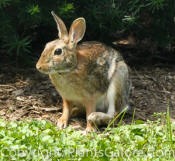 With
all the snow on the ground, critters had a difficult time
finding something to eat. Unfortunately, many of them turned
to chewing on stems and trunks of trees and
in the
landscape or orchard.
With
all the snow on the ground, critters had a difficult time
finding something to eat. Unfortunately, many of them turned
to chewing on stems and trunks of trees and
in the
landscape or orchard.
Looking forward to next year, there are only
a handful of techniques for dealing with this
problem. First, you can get rid of the critter. You may be
able to live trap rabbits and take them many miles away but
for deer, this is not a practical approach for most of us.
Second, repellants can work to persuade the
critters to avoid your plants. These concoctions make things
either taste or smell bad to the potential eater. Commercial
preparations such as Deer Away, Hinder, Tree Guard and others
have been reported to work in many cases. Home remedies based
on peppers, human hair, soap, tankage and other products may
be effective also.
Unfortunately, all the repellants tend to
wash off over time and need to be periodically reapplied. This
can be a challenge in the winter. Also, depending on how many
critters you have and how hungry they are, the repellants may
be effective in one landscape but not in another.
 The
third alternative often employed is to prevent the animal from
having access to the plant. This can include putting up a
temporary chick wire cage to plastic tree guards to protect
the bark of tender young trees. The down size with these is
that they need to be sturdy enough to prevent the damage by
the animals and they must be in place before feeding takes
place. Once two feet of snow is on the ground, it is generally
too late for this approach.
The
third alternative often employed is to prevent the animal from
having access to the plant. This can include putting up a
temporary chick wire cage to plastic tree guards to protect
the bark of tender young trees. The down size with these is
that they need to be sturdy enough to prevent the damage by
the animals and they must be in place before feeding takes
place. Once two feet of snow is on the ground, it is generally
too late for this approach.
What can you do for the plants that have
been damaged? For the most part, you must just wait and see
what happens. If an animal has chewed on the bark of a tree,
the ultimate outcome is dependent on how deep they penetrated.
If they damage the
cambium layer beneath the bark, the plant
will sustain long-term damage. If enough cambium is killed the
entire branch or the entire tree may die.
 Orchardists
use a technique called bridge
grafting or in-arching to try to
save fruit trees. This is most effective when rodents have
chewed around the circumference of the tree near ground level.
Unfortunately, this is not an easy technique to master but, if
you want to give it a try, contact our office and I can send
you instructions.
Orchardists
use a technique called bridge
grafting or in-arching to try to
save fruit trees. This is most effective when rodents have
chewed around the circumference of the tree near ground level.
Unfortunately, this is not an easy technique to master but, if
you want to give it a try, contact our office and I can send
you instructions.
Many
deciduous shrubs such as
forsythia,
spirea,
wiegela and
others will grow back even if severely damaged. You can prune
them back to shape them below the damaged areas and they
should be back in shape in a year or two.
Evergreens such as
arborvitae and yews may
also grow back. The difference is that it might take much
longer for them to fill in empty areas. Many of these types of
plants have a single flush of growth per year and it may take
several seasons for them to develop new buds to re-foliate
areas damaged by critters.



